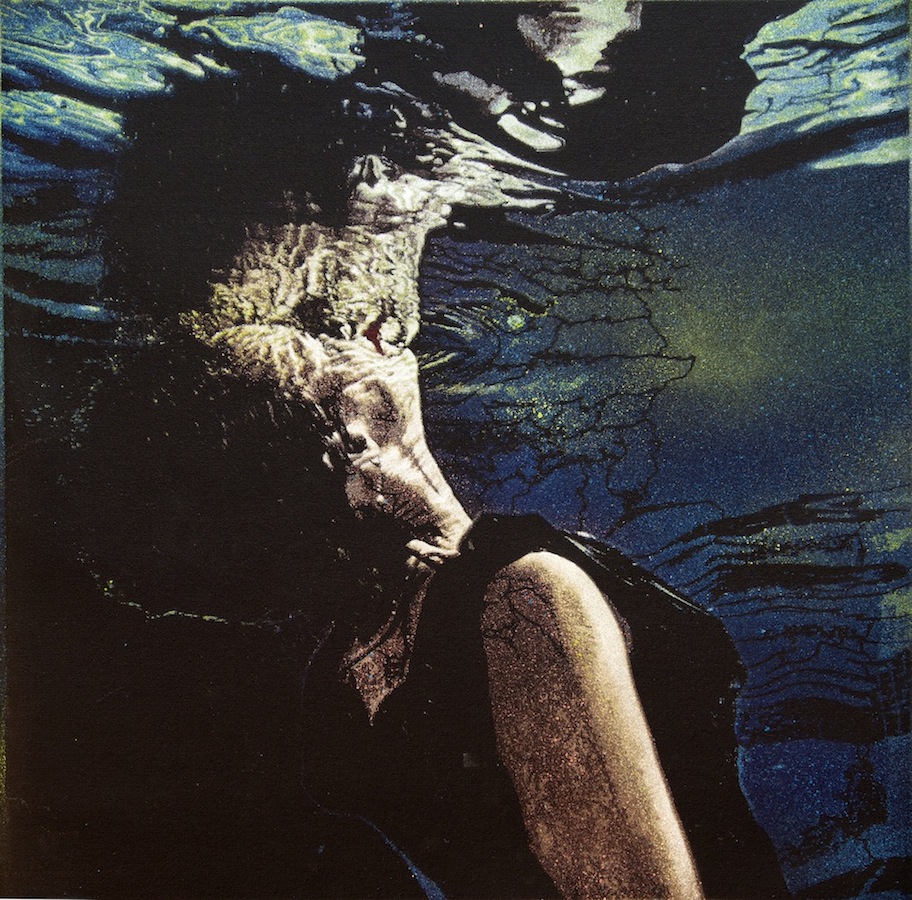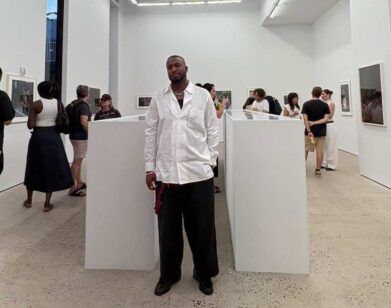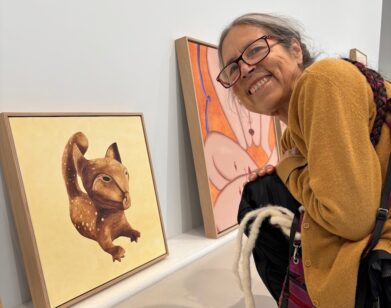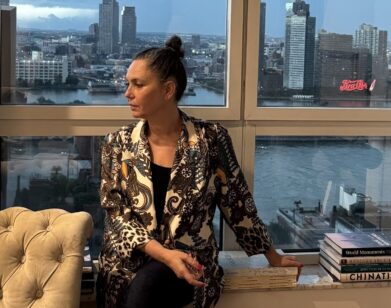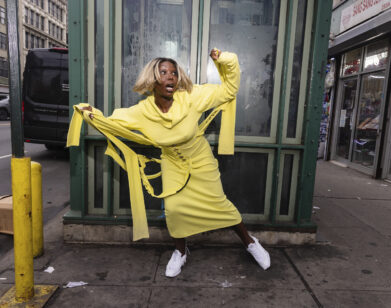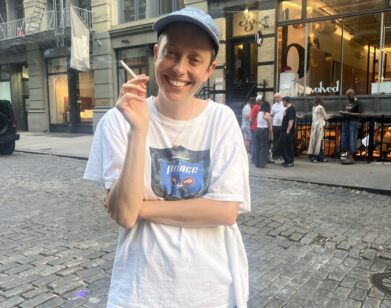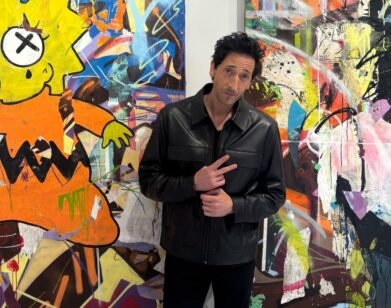Logan Hicks’ Sea Spray
Until recently, New York-based artist Logan Hicks described his work as a succession of one-hit wonders. “I always used to say that I was able to write a song, but not an album,” Hicks says. “This, I feel, is my first cohesive body of work.”
“This” is his new pop-up exhibition, “Love Never Saved Anything,” launching at 154 Stanton Street tonight. It will be Hicks’ second solo show for music moguls Pat Magnarella and Roger Klein’s PMM Art Projects series, a new venture described as a “disruptive art business model” that provides artists with “protection, nurturing, and recognition” without trying to manipulate the direction or outcomes of their work for the purposes of marketability. In this sense, PMMAP is the ultimate anti-agent, allowing artists the freedom to create whatever they wish on their own terms.
PMMAP gave Hicks the time he needed to assemble the show, which took six months to complete. It features a series of nautical-themed paintings depicting all imaginable perspectives of life at sea, from sailors coming home only to leave loved ones behind again, to the mythical nymphs and sirens of Greek mythology waiting to be rescued. Set against black backgrounds, each scene is painted in iridescent sea greens, blues, and yellows, almost as if the light were breaking the water and illuminating the canvas. Even more impressive is Hicks’ use of stencils, illustrating his mastery over them through his delicate, painterly style. Alongside these works, Hicks will also be unveiling never-before-seen photography from his travels.
The show presents a graduation from earlier work that focused primarily on the dichotomies within urban life, honing in on the juxtaposition between the distinct, hard lines of city architecture and the softness of the human forms surrounding it. While the blueprint of his present aesthetic still carries traces of this idea, it is much more woven into the layers of the work—one is given the impression of it long before being able to identify what it is. Prior to this exhibition, Hicks has also shown at national and international festivals, galleries, and museums, including the 2008 Cans festival in London, where he was one of two artists personally selected by Banksy to represent the U.S. He has twice participated in the NuArt festival in Stavanger, Norway, and his work is on permanent display in the Wynwood Wall arts compound in Miami and the Goldman Collection in New York. Later this year, he’ll be showing at international exhibitions in Istanbul and Basel.
NOOR BRARA: So, this show is said to be “inspired by your setbacks” from the last year. Tell me a little bit about that. What is it about being underwater, or at least halfway underwater, that captured that sentiment?
LOGAN HICKS: You know, before this body of work, I was known primarily for architectural works. All of those pieces are kind of made from a passive standpoint—you know, when you’re more an observer than a participant. And last year was just a crappy year. Pretty much anything that could go wrong did go wrong, and at the time I was doing this one piece of a figure that just looked like she was floating there; we did a shoot underwater, and I really liked the whole feel of it: the floating, the drifting, the weightlessness. And it’s not like you consciously think, “Oh, that’s me,” but that sort of feel is what I was going through. So I just sort of pursued that path; and what started off as this feeling of weightless bodies then led me to different nautical themes and sailor traditions and Greek mythology and everything else. That’s how I kind of got to this point. And now, with the figures, it’s more from this narrative standpoint than the observer standpoint.
BRARA: “Love Never Saved Anything” is the title. I was wondering if you believed that.
HICKS: It was actually a clip from a conversation I had with a friend of mine last year, and I was kind of just bitching about losing a few things… finances, relationships, all kinds of stuff. My friend, the optimist, was like, “Well, at least you’re doing something you love.” I said, “Yeah, but love never saved anything.” It was one of those things where you reflect on the conversations that you’ve had, and I was just like, “Huh. That’s a particularly pessimistic outlook.” But even though it tends to be pessimistic, for me it’s not meant to be. It’s really that it’s about a lot of hard work, and thought, and patience, and knowing where you want to go that really saves everything. Not just sitting around and loving things. So there is an optimistic side to it.
BRARA: And I feel like that’s definitely reflected in the work. There is obviously a dark aspect to it, but one of the things I noticed was that it has a kind of light that carries a glimmer of hope in the opalescence of the color. It really shines through.
HICKS: You know, one thing I’ve noticed with the nautical stories—in any culture or tradition—is that they all revolve around love, death, salvation, fame, riches, whatever. So I see a lot of these as representing the calm before the storm—that action before something happens, whether it’s good or bad. Certainly, on some level, I’d like to think I’m optimistic so the painting reflects that somehow.
BRARA: Yeah. In that same respect, when you were depicting these scenes, did you draw from your own experiences in relationships and from the people that you know?
HICKS: I draw from the feelings of what I’m going through, but not necessarily the actual thing that happened. I think, with art, the most successful art is the kind in which you can put yourself into it, but I’m not trying to tell my life story… “And then this happened to me,” that sort of thing. But, you sort of use that feeling as the pivot point from which you tell a story, and any external things that kind of support that—whether it’s the sirens of the sea or Greek mythology or whatever else—so I just used that as my platform to speak from.
BRARA: One of the themes, as you mentioned earlier, is the superstitions and traditions of sailors. As a viewer, I can see why that’s true—several of your paintings depict men dressed as sailors saving drowning damsels, sometimes leaving women that appear to love them. What is your connection to sailors? Do you relate to them?
HICKS: With the whole nautical world—the visuals, especially because it’s such a rich lexicon with their traditions and stories, some of them are so absurd, but you can see them in your head as you’re reading them. That’s one of the things that drew me in. But I’ve always had this attachment to water. I’m a Pisces, I’ve always lived near water, my dad was in the Navy, my son’s name is Sailor. So there’s a lot that goes into it, really. But also, just that image of a boat floating in a vast sea—it parallels a lot of the feelings that I had. And it was just one of those things… you find parallel stories to tell your story and that one made a lot of sense to me.
BRARA: Any works that are favorites, or ones that you’re particularly proud of?
HICKS: Still to be determined! I’ve got to spray more out today. I think I really like the larger ones, though—the more life-sized you can make them, the more believable they are. There’s one, when I was over in the U.K. doing a show in the north over there, for which I made a friend of mine walk out into the North Sea in the middle of November in a wedding dress. I don’t think she was particularly happy about that, but that’s what a true friend does, I guess. And the tide was so strong there that I worried about her dying…
BRARA: [laughs] Oh, I’m sure. Death by art. In your work Pull of the Sirens, the sailor shown looks a lot like you. Is that you?
HICKS: [laughs] You know, if I didn’t think it was so cheesy to include myself, I probably would have, but I was directing the shoot, so I used my friend instead. But the majority of the people I use are my friends. Like in Pulled Out, the man portrayed is my business partner and the woman is my yoga instructor.
BRARA: That’s cool that you have personal connections to these people and then they become characters in your work. Women also play a major part in your show. I especially liked the painting of Circe emptying the bottle of poison into the water—standing there, sort of beautiful but deadly. Can you speak a little bit about this?
HICKS: For me a lot of the trouble stems from women, and that’s from where I’m talking, but also when I paint, I tend to paint this idealized beauty and for me it comes from women. If I started speaking about generalized beauty in a man, it just wouldn’t be sincere. So, I talk through the language that’s most native for me and that’s the female form. With the Circe one—there’s a painting by a guy named John Waterhouse that I really love and I happened to come across it recently and started reading up on the legend of her, so I wanted to do my interpretation of it.
BRARA: There’s this idea of absolute beauty but also trickery and deception, I think, in all of your female characters.
HICKS: Yeah, you look at the sirens and the idea of being lured in by these beautiful voices comes through, but then you’re devoured. It sort of relates back to the same thing of the architecture work, in the hard lines but the soft form, this black and white, good and bad…
BRARA: Two sides of the same thing.
HICKS: Exactly.
BRARA: Take me through the process of how you make a stencil, how you make a final work. I know it comes from a photograph first.
HICKS: Yeah. First is the idea, so I figure out what I want to do. Then set up the photo shoot, and I’ve had some good friends along the way that have helped me out with finding pools or studio space or whatever else. From there, you take the photo and you break it down into high, medium, and low contrasts. You cut a stencil of each of these, and then you layer it up exactly the same way you would a screen print. And I come from a screen print background, so a lot of my approach stems from that. I’ve obviously refined it over the years to suit my needs. It used to be that I would work only in monochromatic color schemes, but then a couple years ago I started adding color. And then with this recent work, I’ve been trying to get more painterly with stuff. And instead of seeing stencils and playing with the limitations of that [medium], I’ve been trying to get past that to see the stencils the same way an artist would see a brush.
BRARA: Yeah. I’ve seen examples from your previous shows, and there’s definitely a difference in terms of being able to identify the medium. It’s more invisible now. For this work, I wouldn’t have been able to tell that the images came from stencils had I not known.
HICKS: I like transcending that boundary. Because stenciling is actually such a crude medium. At the root of it, you cut a hole in a piece of paper and you spray paint through it. You know? And to be able to take that, and make it sing, for me, is one of the more fun things to do.
BRARA: Yeah. It’s really cool, because the lines the lines of your stencils are so fine. I was wondering how long it took to make just one stencil.
HICKS: Well, now I have machines for that. For seven or eight years, I hand-cut everything—the last piece I cut was like a 13-by-15 foot piece and I spent three and a half weeks, seven days a week, 12 hours a day, working on it. So it just got to a point where I didn’t know if I was cutting for bragging rights, or if it was sort of the right way to produce the thing. And I realized that at the end of the day, the work… you do what the work demands. And while the hand-cutting was nice or meditative or whatever, machining it allowed me to increase my vocabulary.
BRARA: Right. Also, I’m not sure if this is intentional or not, but I noticed an interesting astral quality to the texture of the paint that reminded me a little of far-off stars. Did you do that on purpose, or did you think about the texture in a particular way?
HICKS: Not necessarily, but I do try to control the diameter of the splatter. I like stuff that when you’re far away, it reads as one thing, but then when you get in, it has that kind of dithered quality to it. So I do try to push that as much as I can, and it’s a mix of making, you know, fine mist and then really big splatters. But yeah, it’s not directly relating to stratosphere stuff, but the technique of it, a little. If you’re going to use spray paint, you should at least give a nod to it, and the way that I do that is kind of through the texture—you sort of tip your hat to it by showing it as being spray paint.
BRARA: That’s a good way of putting it. So, when did you start getting into art? Street art?
HICKS: I’ve always been really into art. I spent most of the time in my room drawing and imagining stuff. My mom really encouraged me; she’s probably the reason why I became an artist. With street art… it was screen-printing before this, and I was actually in art college in Baltimore and I discovered that I just really didn’t like the art world. Especially before the Internet, I mean, the art that you saw… you were pretty much relegated to the art in magazines or that was in your city. There wasn’t this connectivity that there is today. I was also really influenced by Juxtapoz magazine when it came out—that’s where I found out about Shepard Fairey, who I really like. I saw what he was doing and he keyed me into other street artists like Phil Frost and Dave Kinsey. That’s what kind of led me down the path. But I also think I get lumped into street art even though I don’t think that I’m necessarily a part of it; I think it’s for lack of definition more so that a suitable label.
BRARA: Yeah, I wouldn’t look at your work, or what it is today, and immediately think “street art.” Tell me a little bit about your experiences with Banksy. Did you meet him personally? How did he come across your work?
HICKS: The stenciling community is a pretty small one, and especially back then, we all knew of each other. Oddly enough, I actually did meet him—years before, though. I was at a friend of mine’s—she’s British—apartment in L.A. and it was nothing to have another guy speaking with a British accent. I was like, “So hey, what do you do?” and he was like, “I draw stencils,” and I was like, “No shit, me too!” And after he left my friend was like, “Yeah, no, that was Banksy.”
BRARA: Oh my god.
HICKS: I know, I was like, “You bitch, why didn’t you say anything!” But I think the short answer for how he found my work is, I don’t really know. I think he just told his people, “Pick these people.” Our work had appeared in the same books before. It’s such a small circle that everyone just knows each other.
BRARA: And what do you feel this show says about where you’ve arrived as an artist?
HICKS: I think everything has become more in line with who I am. I used to hide behind the technicalities of the work, thinking that that was me letting myself go, but I think you really need to put yourself out there. If you really want people to involve themselves one hundred percent, you need to do the same. People don’t give a shit about the technical stuff. Ultimately, the painting should come first, not the production. If people can connect on any emotional level—although there is a narrative and backstory in mind—it’s really all relevant. So yeah, I think it’s great when people can connect to the art in their own way, and see it as more than just a pretty picture.
LOGAN HICKS’ “LOVE NEVER SAVED ANYTHING” IS ON VIEW AT 154 STANTON STREET TONIGHT THROUGH MARCH 19.

